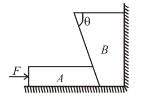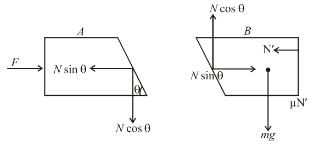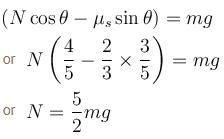Physics Exam > Physics Questions > In the figure shown, the coefficient of stati...
Start Learning for Free
In the figure shown, the coefficient of static friction between B and the wall is 2/3 and the coefficient of kinetic friction between B and the wall is 1/3. Other contacts are smooth. Find the minimum force F required to lift B, up. It is  then x is. Mass of A is 2m and the mass of B is m. Take tan θ = 3/4.
then x is. Mass of A is 2m and the mass of B is m. Take tan θ = 3/4.
 then x is. Mass of A is 2m and the mass of B is m. Take tan θ = 3/4.
then x is. Mass of A is 2m and the mass of B is m. Take tan θ = 3/4.
Correct answer is '3'. Can you explain this answer?
| FREE This question is part of | Download PDF Attempt this Test |
Verified Answer
In the figure shown, the coefficient of static friction betweenB and t...
The F.B.D. of A and B are

For A to be in equilibrium

for B to just lift off

For horizontal equilibrium of B

From (2) and (3)

From equation (1)

The correct answer is: 3

for B to just lift off

For horizontal equilibrium of B

From (2) and (3)

From equation (1)

The correct answer is: 3
Most Upvoted Answer
In the figure shown, the coefficient of static friction betweenB and t...
The F.B.D. of A and B are

For A to be in equilibrium

for B to just lift off

For horizontal equilibrium of B

From (2) and (3)

From equation (1)

The correct answer is: 3

for B to just lift off

For horizontal equilibrium of B

From (2) and (3)

From equation (1)

The correct answer is: 3
Free Test
FREE
| Start Free Test |
Community Answer
In the figure shown, the coefficient of static friction betweenB and t...
The F.B.D. of A and B are

For A to be in equilibrium

for B to just lift off

For horizontal equilibrium of B

From (2) and (3)

From equation (1)

The correct answer is: 3

for B to just lift off

For horizontal equilibrium of B

From (2) and (3)

From equation (1)

The correct answer is: 3

|
Explore Courses for Physics exam
|

|
Similar Physics Doubts
In the figure shown, the coefficient of static friction betweenB and the wall is 2/3 and the coefficient of kinetic friction betweenBand the wall is 1/3. Other contacts are smooth. Find the minimum forceFrequired to liftB, up. It is thenxis. Mass ofAis2mand the mass ofBism. Taketanθ = 3/4.Correct answer is '3'. Can you explain this answer?
Question Description
In the figure shown, the coefficient of static friction betweenB and the wall is 2/3 and the coefficient of kinetic friction betweenBand the wall is 1/3. Other contacts are smooth. Find the minimum forceFrequired to liftB, up. It is thenxis. Mass ofAis2mand the mass ofBism. Taketanθ = 3/4.Correct answer is '3'. Can you explain this answer? for Physics 2024 is part of Physics preparation. The Question and answers have been prepared according to the Physics exam syllabus. Information about In the figure shown, the coefficient of static friction betweenB and the wall is 2/3 and the coefficient of kinetic friction betweenBand the wall is 1/3. Other contacts are smooth. Find the minimum forceFrequired to liftB, up. It is thenxis. Mass ofAis2mand the mass ofBism. Taketanθ = 3/4.Correct answer is '3'. Can you explain this answer? covers all topics & solutions for Physics 2024 Exam. Find important definitions, questions, meanings, examples, exercises and tests below for In the figure shown, the coefficient of static friction betweenB and the wall is 2/3 and the coefficient of kinetic friction betweenBand the wall is 1/3. Other contacts are smooth. Find the minimum forceFrequired to liftB, up. It is thenxis. Mass ofAis2mand the mass ofBism. Taketanθ = 3/4.Correct answer is '3'. Can you explain this answer?.
In the figure shown, the coefficient of static friction betweenB and the wall is 2/3 and the coefficient of kinetic friction betweenBand the wall is 1/3. Other contacts are smooth. Find the minimum forceFrequired to liftB, up. It is thenxis. Mass ofAis2mand the mass ofBism. Taketanθ = 3/4.Correct answer is '3'. Can you explain this answer? for Physics 2024 is part of Physics preparation. The Question and answers have been prepared according to the Physics exam syllabus. Information about In the figure shown, the coefficient of static friction betweenB and the wall is 2/3 and the coefficient of kinetic friction betweenBand the wall is 1/3. Other contacts are smooth. Find the minimum forceFrequired to liftB, up. It is thenxis. Mass ofAis2mand the mass ofBism. Taketanθ = 3/4.Correct answer is '3'. Can you explain this answer? covers all topics & solutions for Physics 2024 Exam. Find important definitions, questions, meanings, examples, exercises and tests below for In the figure shown, the coefficient of static friction betweenB and the wall is 2/3 and the coefficient of kinetic friction betweenBand the wall is 1/3. Other contacts are smooth. Find the minimum forceFrequired to liftB, up. It is thenxis. Mass ofAis2mand the mass ofBism. Taketanθ = 3/4.Correct answer is '3'. Can you explain this answer?.
Solutions for In the figure shown, the coefficient of static friction betweenB and the wall is 2/3 and the coefficient of kinetic friction betweenBand the wall is 1/3. Other contacts are smooth. Find the minimum forceFrequired to liftB, up. It is thenxis. Mass ofAis2mand the mass ofBism. Taketanθ = 3/4.Correct answer is '3'. Can you explain this answer? in English & in Hindi are available as part of our courses for Physics.
Download more important topics, notes, lectures and mock test series for Physics Exam by signing up for free.
Here you can find the meaning of In the figure shown, the coefficient of static friction betweenB and the wall is 2/3 and the coefficient of kinetic friction betweenBand the wall is 1/3. Other contacts are smooth. Find the minimum forceFrequired to liftB, up. It is thenxis. Mass ofAis2mand the mass ofBism. Taketanθ = 3/4.Correct answer is '3'. Can you explain this answer? defined & explained in the simplest way possible. Besides giving the explanation of
In the figure shown, the coefficient of static friction betweenB and the wall is 2/3 and the coefficient of kinetic friction betweenBand the wall is 1/3. Other contacts are smooth. Find the minimum forceFrequired to liftB, up. It is thenxis. Mass ofAis2mand the mass ofBism. Taketanθ = 3/4.Correct answer is '3'. Can you explain this answer?, a detailed solution for In the figure shown, the coefficient of static friction betweenB and the wall is 2/3 and the coefficient of kinetic friction betweenBand the wall is 1/3. Other contacts are smooth. Find the minimum forceFrequired to liftB, up. It is thenxis. Mass ofAis2mand the mass ofBism. Taketanθ = 3/4.Correct answer is '3'. Can you explain this answer? has been provided alongside types of In the figure shown, the coefficient of static friction betweenB and the wall is 2/3 and the coefficient of kinetic friction betweenBand the wall is 1/3. Other contacts are smooth. Find the minimum forceFrequired to liftB, up. It is thenxis. Mass ofAis2mand the mass ofBism. Taketanθ = 3/4.Correct answer is '3'. Can you explain this answer? theory, EduRev gives you an
ample number of questions to practice In the figure shown, the coefficient of static friction betweenB and the wall is 2/3 and the coefficient of kinetic friction betweenBand the wall is 1/3. Other contacts are smooth. Find the minimum forceFrequired to liftB, up. It is thenxis. Mass ofAis2mand the mass ofBism. Taketanθ = 3/4.Correct answer is '3'. Can you explain this answer? tests, examples and also practice Physics tests.

|
Explore Courses for Physics exam
|

|
Suggested Free Tests
Signup for Free!
Signup to see your scores go up within 7 days! Learn & Practice with 1000+ FREE Notes, Videos & Tests.


















